As we enter the latter part of the field hemp growing season, it always gives me satisfaction to see the mature plants standing strong and building themselves out to support the flowering stage. It’s at this time of year that we are especially vigilant for diseases that may attack the buds, leaves, and stems of our plants. Today, I want to go into a few common diseases we see across the US that attack various parts of hemp plants as we approach the harvest.
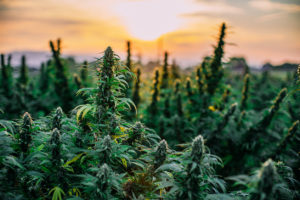
Contributing factors
The diseases we fight in our hemp fields will vary somewhat by region. Environmental factors like humidity, average temperatures, elevation, and stress are considerably different from state to state, and even within certain states that have wide-ranging growing conditions. The environment influences how successful certain pathogens are. Fungi, bacteria, viruses, and nematodes thrive under diverse conditions. It pays to know which pathogens are most pernicious in your area and your local extension office likely has a list they can share with you. Being aware of plant symptomology and being extra diligent about walking the rows will put you in the right position to act quickly to get ahead of diseases before they total your crop. Let’s talk about some commonplace things to watch for.

Powdery mildew
Molds and powdery mildew are caused by fungi and can show up on both leaves and buds as powdery white patches. There are numerous chemical sprays and biological controls you can turn to help prevent an epidemic. A local, reputable ag supplier with hemp cultivation knowledge can recommend the best treatment for your area. Meanwhile, remove infected leaves as soon as you see them – and catch them early! Adequate nitrogen levels will also help. Overhead irrigation, shade, and lack of ventilation may encourage the development of powdery mildew – and these are all factors we can take control of in our fields to prevent outbreaks.
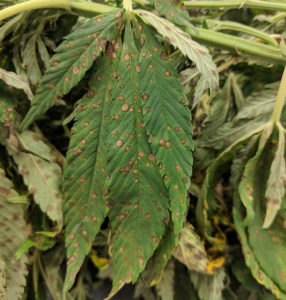
Leaf blight
Like most fungi, leaf blight is a big fan of excess moisture and humidity, so it typically starts to show up in the shady inner canopy. Look for yellow spots with a brown bullseye. Over time, these spots will expand and the centers will change to white or gray. The yellow outlines will also grow outward. Small black dots that look like ground pepper may also appear. You can take steps to improve the environment by thinning your plants, keeping them healthy, and mulching.
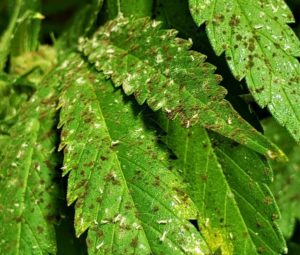
Aphids and Sooty Mold
These two go hand-in-hand. Aphids look like tiny white flecks on leaves and stems; you may also see evidence of darker exoskeletons that get cast off as these critters grow. They can really do a number on the vigor of a plant by sucking out plant fluids, leading to wilting, yellow leaves, and slower growth. Another lovely byproduct of aphids is “honeydew” – an excretion that appears as sticky, sugary, shiny spots. Left to accumulate, these shiny spots can provide a growing medium for dark, soot-like mold. When things go this far, your crop is definitely under a severe threat. The best course is to catch aphids early on and deal with them, even if it requires lots of row-walking and a magnifying glass. There are both chemical and organic bug controls at your disposal. As always, we recommend you talk to local experts about what’s been proven most effective in neighboring fields.
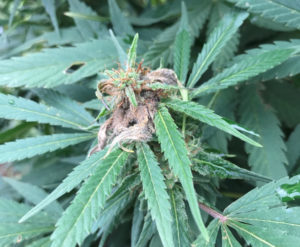
Stem canker
This nefarious fungus is a doozy since it will attack the high-value hemp bud as well as the stem of your plant. It first appears as white mycelium on leaves and stems, which eventually causes wilt and can takeover and destroy buds. There are several pre- and post-emergent treatments that can help head off a total crop takeover, but your best option is to follow practices that discourage the fungus altogether. Preventive measures include buying reliable, quality seed, deep plowing, field flooding, and checking soil before planting for remnants of sclerotia.
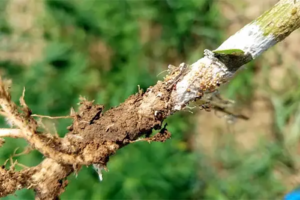
Stem rot
As with stem canker, stem rot may initially appear as a whitish mold or as a brownish or black stem, typically at the base of the plant. And also like stem canker, the rot will eventually lead to wilt and then the death of the plant. Leaves will go from yellow to brown and then drop. In addition to removing diseased plants, the course of action is similar to dealing with stem canker. Seek out treatments recommended by your local experts and take preventive steps before planting to end run the rot!
Prevention
Preventing disease is infinitely preferable and much more efficient that fighting a disease that is trying to take over your grow. Start by purchasing seeds from a reputable seller known for quality and consistency. Choose strains known for disease resistance. Test your plot thoroughly before planting to check for potential pathogens and nematodes, then act accordingly. Likewise, make sure your water is free of potential pests or poisons. Set your plants at recommended distances; rows that are too crowded can reduce airflow around plants, encouraging certain pests and fungus. When you find a diseased plant, remove it immediately. Make sure that you and your cultivation team follow best practices while in the field to prevent introducing or spreading disease with human contact or tools that are not sterile. And, finally, deep tilling after harvest can help thwart the survivability of many pathogens, which gives you a better start the next season.
Maintain vigilance approaching harvest
We’ve come a long way since the spring! From tiny seeds to towering, flowering plants – it’s a journey that can be so rewarding. We still have a way to go to get our crops out of the fields and into a successful, profitable post-harvest processing. The byword now is: vigilance. Watching our crops closely every day for signs of disease positions us to catch problems while they are small. Small problems are easier, faster, and less expensive to deal with that large ones. Eliminating pests and disease as soon as they appear will help us all maximize our revenue for the 2022 season.


Recent Comments